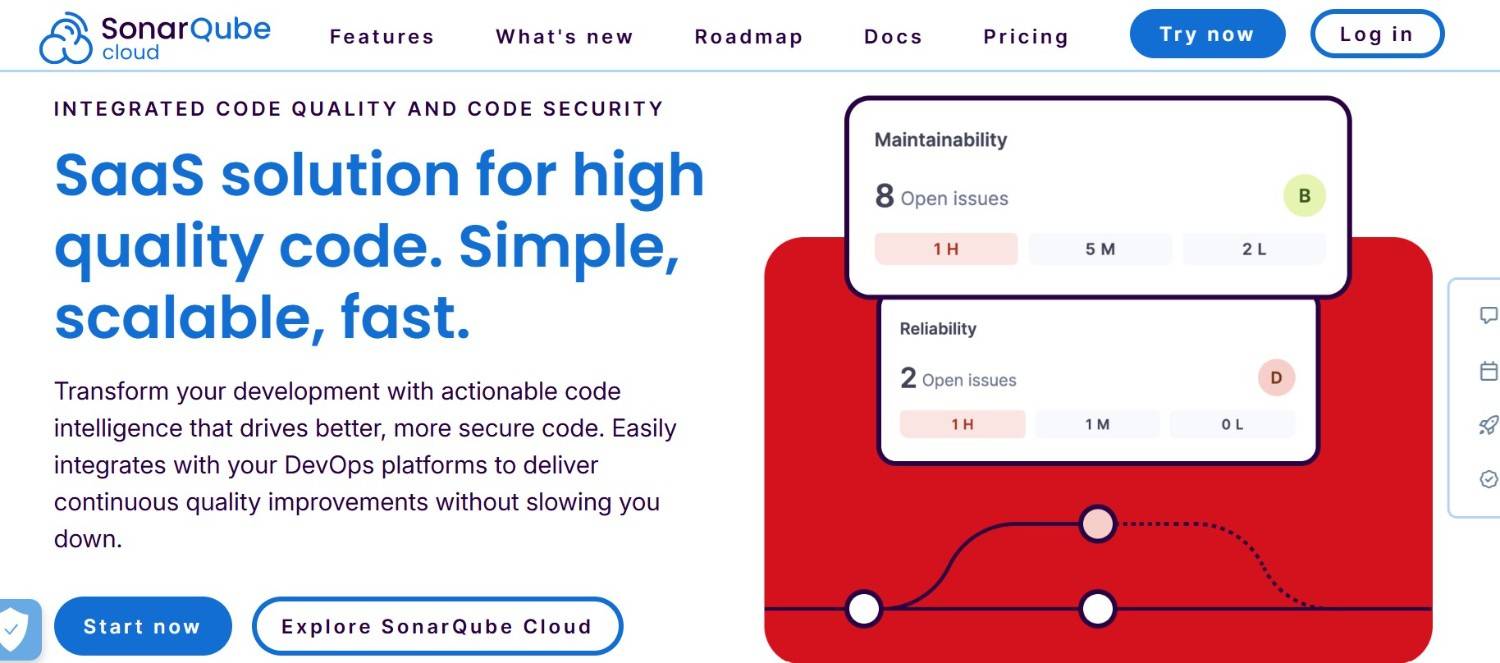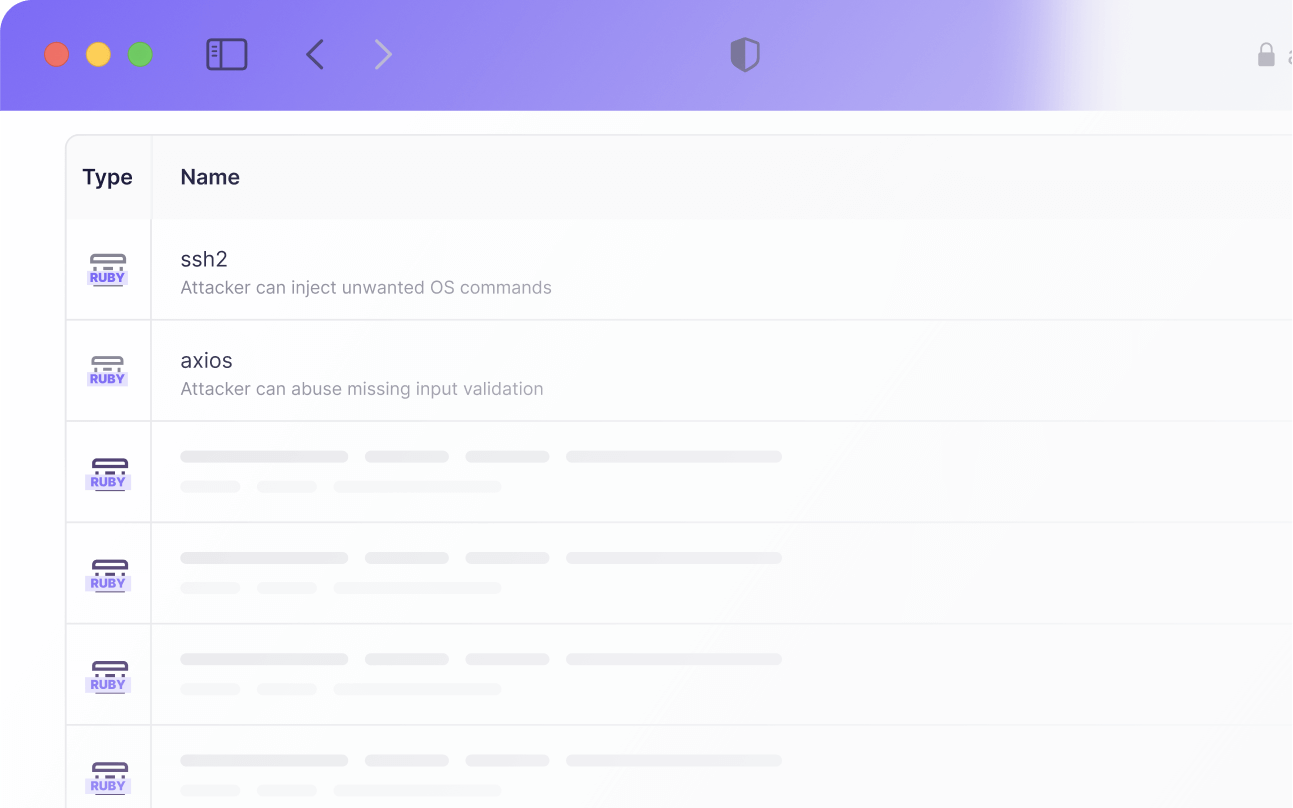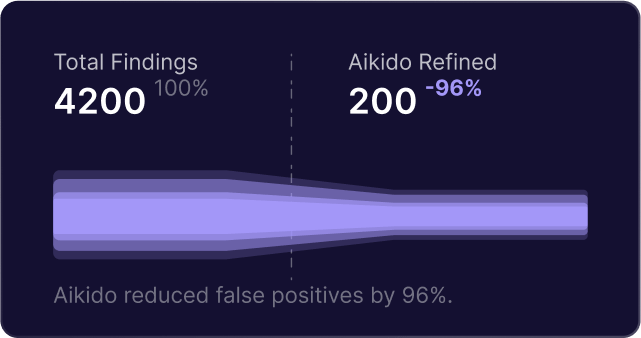Introduction
Choosing the right code security tool can make or break your development workflow. In this post, we compare SonarQube and GitHub Advanced Security (GHAS) from a software security leader’s perspective. Both tools aim to secure your codebase but differ in focus and coverage. We’ll explore how these differences impact real-world teams – from security coverage to integration and developer productivity.
TL;DR
SonarQube and GitHub Advanced Security each cover different layers of risk, but both have blind spots. GHAS emphasizes supply chain and secret scanning within GitHub, while SonarQube targets static code quality. If you rely on one alone, you’ll likely miss threats the other could catch. Aikido Security brings both worlds together in one platform – comprehensive code & dependency scanning – with far fewer false positives and friction. It’s the better choice for modern security teams that demand complete coverage and developer-friendly integration.
Overview of Each Tool
SonarQube
SonarQube is an open-source platform for continuous code inspection. Development teams use SonarQube to scan source code for bugs, code smells, and some security weaknesses before release. Its static analysis engine checks code against thousands of rules for code quality and common security issues. SonarQube supports over 27 programming languages, providing one dashboard to track code health across polyglot projects. Engineering leaders often implement SonarQube as a “quality gate” – if new code introduces critical issues or lacks test coverage, the build can fail to enforce best practices.
However, SonarQube’s security focus is limited compared to dedicated AppSec tools. It mainly flags common vulnerability patterns and “hotspots” for manual review, rather than performing deep exploitable analysis. SonarQube doesn’t analyze your open-source dependencies for known CVEs, nor scan containers or infrastructure configs. These gaps mean teams must supplement SonarQube with other scanners, increasing complexity.
GitHub Advanced Security (GHAS)
GitHub Advanced Security is a suite of native security features for code hosted on GitHub Enterprise. It integrates directly into your repositories and pull requests. GHAS includes CodeQL static analysis for deep code vulnerability scanning, secret scanning to catch leaked credentials, and dependency scanning via Dependabot alerts. Because it’s built into GitHub, security alerts show up in PRs, issues, and the repository security tab with no separate dashboard to log into. For teams already on GitHub, this means minimal setup and seamless workflow integration.
GHAS only works for code on GitHub’s platform – it’s not available for Bitbucket, GitLab, or on-prem repos. It’s a paid add-on for GitHub Enterprise accounts, activated per repository. GHAS focuses purely on security (code and supply chain) rather than general code quality. It helps catch vulnerabilities early in development without leaving GitHub, but as we’ll see, it doesn’t cover everything.
Feature-by-Feature Comparison
Now, let’s dive into how SonarQube and GHAS compare on key aspects that matter to technical leaders.
Core Security Capabilities
SonarQube is primarily a SAST (static application security testing) tool with a heavy emphasis on code quality. It scans your application’s source code for bugs and some known vulnerability patterns, but its depth in security testing is limited. SonarQube will spot things like SQL injection patterns or use of weak cryptography, but many findings are marked as “security hotspots” requiring manual review. Crucially, SonarQube lacks built-in scanning for open-source dependency vulnerabilities, container images, or infrastructure-as-code issues. It’s looking only at your custom code, and even there it may miss complex flaws that go beyond its pattern-based rules.
GitHub Advanced Security, on the other hand, tackles security across code and dependencies. Its CodeQL engine performs semantic static analysis to find code vulnerabilities (with high precision on the patterns it knows). GHAS also monitors your third-party libraries for known CVEs via dependency scanning and locks down secrets to prevent leaks. This means GHAS covers software supply chain risks out-of-the-box – an area SonarQube simply doesn’t address. However, neither tool provides dynamic testing (DAST) or comprehensive container scanning natively. GHAS can orchestrate third-party scanners (e.g. container or IaC scans via actions), but those require additional setup.
In short, GHAS covers more security surface (code + secrets + dependencies) while SonarQube focuses on static code issues, leaving big blind spots in open-source and runtime security. A team using SonarQube alone would need extra tools to cover SCA, container, and cloud scans – complexity that GHAS attempts to reduce by bundling those features.
Integration & DevOps Workflow
When it comes to fitting into your pipeline, the two tools differ significantly. SonarQube can integrate with many CI/CD systems (Jenkins, GitLab CI, Azure DevOps, etc.) and works with various version control platforms. Typically, you run a Sonar scanner during the build, and results are published to a SonarQube server or SonarCloud. This flexibility is great – you’re not tied to a specific platform – but it also means more setup and maintenance. Teams often struggle to seamlessly weave SonarQube into the dev workflow. You might need to tweak pipeline configs, manage webhooks for PR decoration, and deal with a separate web UI. SonarQube isn’t deeply integrated into git hosting platforms; it often feels like an external checkpoint.
GitHub Advanced Security is, by design, tightly integrated into the GitHub workflow. If your code lives on GitHub, enabling GHAS means security scans run automatically on each push or pull request via GitHub Actions. Developers see CodeQL findings as comments on their pull requests or in the repository’s Security tab – no separate app or context-switching needed. The security feedback is delivered in-line during code review, which developers tend to appreciate. The flip side is lock-in: GHAS only works on GitHub’s ecosystem.
You can’t use it on GitLab or Bitbucket repos, and its features are inaccessible outside GitHub. So while GHAS provides a smoother experience for GitHub-centric teams, SonarQube offers broader integration flexibility across different CI/CD and SCM platforms. Also, using SonarQube on-premises or via SonarCloud lets you retain more control over data and customization, whereas GHAS is a cloud service tied to GitHub’s pricing and policies.
Accuracy and Performance
A critical concern in any security tool is how noisy it is and how much it actually catches. SonarQube has a known reputation for high false positives – flagging benign code as issues. Teams often experience “alert fatigue” with SonarQube, where numerous low-priority findings cause engineers to start ignoring the tool. In practice, SonarQube can miss serious security bugs (false negatives) while also raising many minor or dubious warnings. Many of its security rules are simple pattern checks, which means they can cry wolf or require manual triage to determine actual risk. This noise can waste developer time and erode trust in the tool’s results. Performance-wise, SonarQube analysis runs in the CI pipeline and is usually moderate in speed – often a few minutes for a large codebase. It can slow down builds if not tuned, but it’s generally tolerable.
GitHub Advanced Security’s CodeQL is more advanced in its analysis, which often translates to fewer false positives on the vulnerability types it knows. CodeQL has strong dataflow analysis for certain flaw classes, so when it flags something like an XSS or SQLi, it’s likely a real issue. However, GHAS is not immune to noise – dependency scanning can flood you with alerts if your project has many outdated libraries, and CodeQL will only find what it has queries for. Some users report that GHAS can overwhelm them with low-value findings that require tuning or ignoring of certain rules.
On the performance front, CodeQL analysis is relatively heavy. Running GHAS scans via GitHub Actions might add a minute or two to each PR’s checks (in one test it was the slowest scanner). The bottom line: GHAS tends to be more accurate for standard vulnerability patterns and produces less random noise than SonarQube, but it can still miss complex logic flaws unless you write custom queries. SonarQube, meanwhile, might catch a broader set of code quality issues but at the cost of more false alarms.
Coverage and Scope
In terms of what each tool actually covers, their scopes are very different. SonarQube covers a wide array of programming languages and code quality domains, but a narrow range of security testing types. It supports 20+ languages from Java, C#, and Python to COBOL and PL/SQL – great for polyglot codebases. SonarQube also tracks code quality metrics (maintainability, duplication, test coverage, etc.), which GHAS doesn’t do.
However, SonarQube’s security coverage is limited to static code analysis (SAST) within your code. It doesn’t scan open-source dependencies for known vulnerabilities, doesn’t examine container images, and won’t check your cloud or IaC configs. For modern applications, that leaves significant blind spots – for example, studies show 80%+ of codebases contain open-source vulnerabilities that SonarQube alone would never flag. Teams end up adding separate SCA and container scanners alongside SonarQube, increasing tool sprawl.
GitHub Advanced Security’s scope is both broader and narrower. It’s broader in that GHAS covers your code and your dependencies and secrets, and even some configuration issues. GHAS will alert you to vulnerable npm packages or Python libraries in your project (SonarQube won’t catch those). It will also prevent developers from committing AWS keys or other secrets. But GHAS is narrower in language support and in focusing purely on security. CodeQL supports the major languages (Java, JavaScript/TypeScript, Python, C/C++, C#, Go, Ruby, plus recently Swift), but if your stack includes something outside that list (PHP, COBOL, etc.), GHAS won’t cover it, whereas SonarQube likely would.
GHAS also doesn’t provide any feedback on code maintainability or style – no info on duplicate code, complexity, etc. And like SonarQube, it doesn’t natively scan running apps or APIs (no DAST) or container images (without third-party integration). In summary, GHAS offers deeper security coverage within GitHub (covering code and supply chain), while SonarQube offers broader language and quality coverage. Many organizations actually use both: SonarQube to ensure clean, maintainable code across many languages, and GHAS to add security scanning of code and dependencies on GitHub. Comprehensive platforms like Aikido aim to replace that combo by covering all these aspects in one solution.
CapabilitySonarQubeGHASAikido Security Static Code Analysis (SAST)✓ (code quality focus)✓ (security focus)✓ (unified)Open Source Dependency Scan✗✓✓Secret Detection✗✓✓
Capability (cont.)SonarQubeGHASAikido Security Container Image Scanning✗✗ (via add-ons)✓Infrastructure as Code Scan✗✗✓Code Quality Metrics✓✗Partial
(✓ = Supported natively; ✗ = Not supported)
Developer Experience
Adoption by developers is critical. A security tool that frustrates engineers will end up shelved or ignored. SonarQube’s developer experience has some challenges. Setting up SonarQube often requires managing a server, configuring quality profiles, and dealing with a web UI that can feel clunky. Developers typically interact with SonarQube through its web interface or via PR comments. The UI, while powerful, isn’t very intuitive or modern. Many devs see SonarQube as a tool for the CI pipeline rather than something that helps them day-to-day. There are plugins like SonarLint for IDEs to provide inline feedback, but not everyone uses them.
Importantly, SonarQube’s high false positive rate can train developers to ignore its alerts over time. If every scan results in dozens of insignificant “code smells,” engineers might start skimming or tuning out the results. That defeats the purpose of having a code security tool.
It’s not real-time feedback either – by default, issues are reported after code is pushed and analyzed in CI, not as you code. This lag, combined with noisy output, means SonarQube can feel more like a mandate than a helper.
GitHub Advanced Security’s developer experience is more seamless if you’re on GitHub. Devs get security feedback as part of code review: a CodeQL alert pops up in pull requests as an annotation on the affected line. There’s no separate login or interface – the alerts live alongside your code, which makes developers more likely to see and act on them. GHAS can even automatically open pull requests to fix vulnerable dependencies, which is a nice quality-of-life improvement. All of this occurs within GitHub, so there’s virtually no training or context-switching needed.
However, there is still potential friction: if GHAS produces many alerts, they can crowd PR discussions and become overwhelming. And remember, GHAS is GitHub-only – developers who use other SCMs or local IDE tooling won’t see those results. Another consideration is that CodeQL’s findings can be quite detailed (data flow traces, etc.), which can intimidate devs who aren’t security experts. It’s powerful info, but may require some training to interpret.
Overall, GHAS likely edges out SonarQube in developer-friendliness for teams already on GitHub – there’s less context switching and the feedback loop is integrated into their normal workflow. SonarQube, while valuable, can feel like a separate process that developers must remember to check. Modern dev-centric security tools (including Aikido) aim to address these pain points by giving inline feedback (IDE plugins, PR comments) and even providing auto-fixes, making security as unobtrusive as possible.
Pricing and Maintenance
Finally, let’s talk costs and upkeep. SonarQube’s Community Edition is free, but it lacks many features. The paid Developer, Enterprise, or Data Center editions unlock security rules, additional language support, and faster analysis – but they come with significant licensing fees. SonarQube is often priced by lines of code or by enterprise tier, which can get very expensive as your codebase grows. This can be prohibitive for large monorepos or organizations with millions of lines of code. If you self-host SonarQube, you also bear the maintenance overhead: running servers, databases, upgrades, etc. That’s effort your team has to invest beyond just using the tool.
GitHub Advanced Security is only available as part of GitHub Enterprise. In other words, to use GHAS on private repos, you need to be on a GitHub Enterprise plan and pay for the GHAS add-on. GitHub’s pricing for this is famously opaque – one reviewer noted it was around $50 per developer per month, on top of Enterprise. This can effectively double your GitHub costs if you roll it out broadly. For large teams, GHAS can be a budget-buster, and smaller companies might not be able to justify it at all.
On the bright side, since it’s a cloud service, you don’t have to manage any infrastructure for GHAS – no servers or maintenance, which is a relief compared to SonarQube’s on-prem setup. But you are locked into GitHub’s ecosystem and pricing. We’ve heard complaints about GitHub’s enterprise sales process being frustrating and the licensing being inflexible.
In summary, neither tool is cheap at scale. SonarQube can become cost-prohibitive as you add more code and need enterprise features, and GHAS carries a steep per-seat cost that can shock the budget. This is where alternatives like Aikido often pitch simplicity: Aikido Security offers a flat, predictable pricing model that’s significantly more affordable at scale than either SonarQube or GHAS. You’re not paying per-line-of-code or per-repo, which can give much better ROI as you grow.
Pros and Cons of Each Tool

SonarQube – Pros:
- Comprehensive Code Quality Analysis: Excellent for enforcing coding standards, catching bugs and code smells across ~27 languages.
- Flexible Integration: Can be self-hosted or used in the cloud (SonarCloud), and integrates with most CI/CD tools – works with GitHub, GitLab, Bitbucket, etc.
- Quality Gate Enforcement: Allows you to set “quality gates” (e.g. no new critical issues) to prevent bad code from merging, helping maintain high code standards.
- Active Ecosystem: Large community and plugin library for custom rules or languages, plus many developers are already familiar with SonarQube’s reports.
SonarQube – Cons:
- Limited Security Scope: Only covers static code, missing vulnerabilities in open-source dependencies, containers, and config – leaving major gaps without additional tools.
- High False Positives: Tends to flag many non-issues, causing alert fatigue. Noise can lead developers to tune out or mistrust findings over time.
- Complex Setup & Maintenance: Requires managing servers, databases, updates, and user management. The interface and rule tuning have a steep learning curve.
- Expensive Scaling: Advanced security rules and enterprise features require paid licenses, which get very costly as your codebase grows.

GitHub Advanced Security – Pros:
- Native GitHub Integration: Seamlessly embeds into GitHub workflows – results appear in pull requests and the Security tab, no extra tools or portals needed.
- Strong Security Focus: Powerful CodeQL static analysis finds serious vulnerabilities with relatively low false-positive rates. Also includes secret scanning and dependency alerts for supply chain security.
- Zero Infrastructure Overhead: Nothing to host or manage – it’s a cloud service handled by GitHub, so setup is as simple as toggling it on for your repos.
- Automated Supply Chain Protection: Can automatically open fix PRs for vulnerable dependencies (via Dependabot), saving developer effort and proactively reducing risk.
GitHub Advanced Security – Cons:
- GitHub-Only: Works only for code on GitHub. Not usable with other repo platforms or on-prem, which limits use in multi-cloud or hybrid scenarios.
- Premium Pricing: Requires GitHub Enterprise plus an add-on fee – often prohibitively expensive per seat. The cost can be a non-starter for large teams or smaller companies.
- Alert Fatigue Potential: Can overwhelm developers with too many findings (e.g. a flood of dependency alerts), creating alert fatigue if not carefully managed.
- Coverage Gaps: Lacks native scanning for key areas like container images or IaC. These blind spots mean you may still need other security tools to cover your full stack.
Aikido Security: The Better Alternative

Both SonarQube and GHAS have strengths, but neither offers a one-stop solution – and their drawbacks (noise, gaps, cost) can hold back your security program. This is where Aikido Security stands out as a superior alternative. Aikido combines broad coverage (static code analysis plus open-source, container, IaC scanning) with far fewer false positives thanks to smart correlation techniques.
It integrates seamlessly into dev workflows (CI/CD pipelines, IDEs, PRs) and even provides AI-assisted auto-fixes for certain issues. The result is an all-in-one, developer-first platform that delivers the benefits of both SonarQube and GHAS – without their noise, blind spots, or steep costs.
Start a free Trial or request a demo to explore the full solution.

Secure your software now





.avif)
